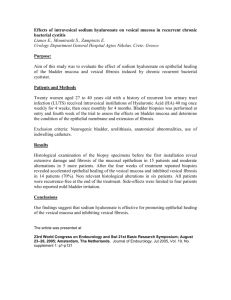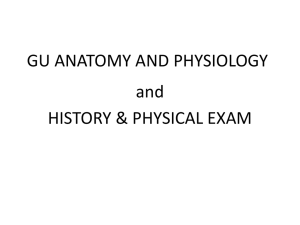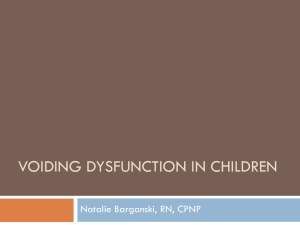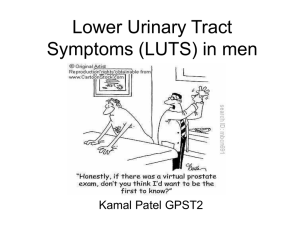Non-malignant diseases of urinary bladder and urethra
advertisement
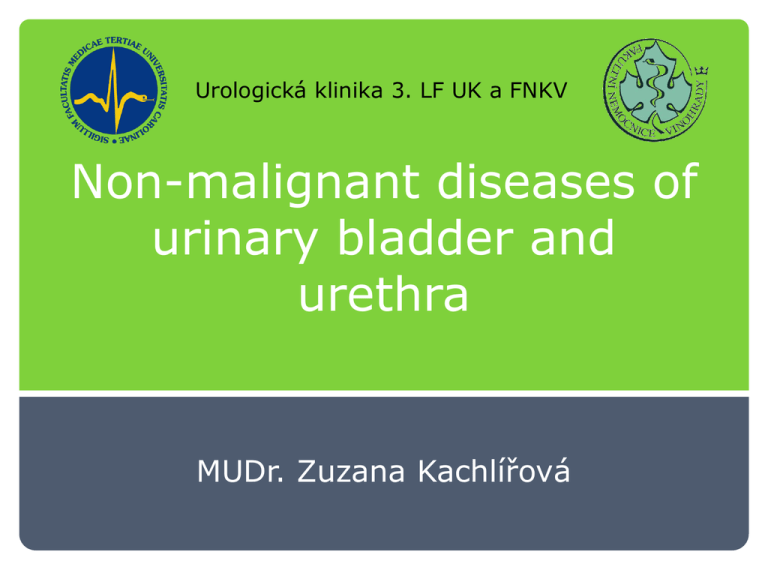
Urologická klinika 3. LF UK a FNKV Non-malignant diseases of urinary bladder and urethra MUDr. Zuzana Kachlířová Acute cystitis Recurrent cystitis Interstitial cystitis Fistulas Uretritis Urethral strictures Cystolithiasis Acute cystitis Acute cystitis Infection of lower urinary tract, principally the bladder More commonly in women than in men Primarly mode: ascendent infection from the periurethral/vaginal and faecal flora Diagnosis is made clinically Presentation and findings Irritative voiding symptoms – dysuria, frequency, urgency Low back and suprapubic pain Haematuria, cloudly/foul-smelling urine Fever and systemic symptoms are rare E. coli Other gram-negative (klebsiella, proteus) or gram-positive (staph. saprophyticus, enterococci) pathogens Risk factors Diabetes mellitus Lifetime history of UTI Intercourse Managemet Short course of oral antibiotics 3-5 days Single dose therapy for treatment of recurrent cystitis less effective Antibiotics TMP-SMX Nitrofurantoin Fluorochinolones Penicillins and aminopenicillins not recommended (high resistance) Recurrent cystitis Recurrent cystitis Caused either by bacterial persistence or reinfection with another organism Bacterial persistence: removal of infected source Reinfection:preventive therapy Bacterial persistence Suspected cause – radiological imaging indicated: - US – screening evaluation of the genitourinary tract - intravenous pyelogram - cystoscopy - CT Frequent, recurrent UTI Bacterial localisation studies More extensive radiologic evaluation (retrograde pyelogram) Evaluation for evidence of vesico-vaginal or vesico-enteric fistulas Management Surgical removal of the infected source (urinary calculi) Surgical repair of the fistula Medical management with prophylactic antibiotics – reduce recurrence of UTI by 95% Alternatively – intermittent self-start antibiotic therapy (in some women) Relation to sexual intercourse – frequent emptying of the bladder + single-dose ATB Alternatives to antibiotic therapy Intravaginal estriol Lactobacillus vagina suppositories Cranberries / cranberry juice orally taken Interstitial cystitis Interstitial cystitis Hunner´s ulcer, submucous fibrosis Primarly a disease of middle-aged women Characterised by fibrosis of the vesical wall with consequent loss of bladder capacity Neuro-immuno-endocrine disorder Principal symptoms: frequency, urgency, pelvic pain with bladder distension Pathogenesis Urine usually normal Fibrosis due to obstruction of vesical lymphatics secondary to infection or pelvic surgery Or neuropathic origin Endocrinologic factors suggested Interstitial cystitis Interstitial cystitis Interstitial cystitis Pathology Primary change is fibrosis in the deeper layers of the bladder – muscle replaced by fibrous tissue Mucosa is thinned Small ulcers or cracks in the mucous membrane Signs of inflammation Normal mechanism of the UV-junction is destroyed - VUR Hydroureteronephrosis and pyelonephritis may ensue Clinical findings Symptoms Signs Laboratory findings X-ray findings Instrumental examination Symptoms of interstitial cystitis Slowly progressive frequency and nocturia History does not suggest infection Suprapubic pain when bladder full Pain experienced in urethra or perineum – relieved on voiding Gross haematuria occasionally (following bladder overdistension) Signs Physical examination usually normal Tenderness in suprapubic area Tenderness in the region of the bladder when palpated through the vagina Laboratory findings Urine free of infection Microscopic haematuria Renal function failure in vesical fibrosis and VUR X-ray findings Excretory urogram – normal VUR Cystogram: small capacity bladder, VUR Instrumental examination Cystoscopy - increase suprapubic pain during the bladder fills - vesical capacity may be as low as 60ml - second hydrodistension: punctate haemorrhagic areas may appear, arcuate split in the mucosa, profusely bleeding - difffuse mucosal changes - congestion, edematous reaction, petechial haemorrhages Biopsy Differential diagnosis TBC Vesical ulcers due to schistosomiasis Treatment NO definitive treatment Hydraulic overdistension to improve the bladder capacity Instillation of 50ml of 50% dimethyl sulfoxide (DMSO) intravesically for 15 minutes every 2 weeks Vesical irrigation of 0,4% oxychlorosene sodium Cortisone acetat or prednisone Antihistamines Heparine sodium New treatments: resiniferotoxin, gene therapy, neuromodulation Surgical treatment In fibrotic bladder, small capacity, VUR, renal failure - ceco- or ileocystoplasty to augment vesical capacity - urinary diversion Denervation by presacral and sacral neurectomy and perivesical procedures (cystolysis, cystoplasty, transvaginal neurotomy) – rarely of lasting benefit Fistulas Fistulas Vesico-vaginal Vesico-rectal Vesico-intestinal Vesico-adnexal Urethro-vaginal Urethro-scrotal Urethro-rectal Retrovesical Vesical fistulas Common Bladder may communicate with the skin, intestinal tract, female reproductive organs Primary disease NOT urologic Causes Primary intestinal disease - diverticulitis 50-60% - colon cancer 20-25% - Crohn disease 10% Primary gynaecologic disease - pressure necrosis during difficult labor - cervix cancer Treatment for gynaecologic disease - hysterectomy - low cesarean section - radiotherapy for tumor Trauma Vesico-intestinal fistula Symptoms: vesical irritability, passage of feces and gas through the urethra, change in bowel habits Examination: barium enema, upper gastrointestinal series, sigmoidoscopy Cystogram – gas in bladder or reflux into bowel Cystoscopy Cathetrisation of the fistulous tract Vesico-intestinal fistula Vesico-vaginal fistula Relatively common Secondary to obstetric, surgical or radiation injury or invasive cervix cancer Constant leackage of urine Pelvic examination Cystoscopy Vaginography Vesico-vaginal fistula Vesico-vaginal fistula Treatment of fistulas Vesico-intestinal fistula - proximal colostomy - resection of the bowel + closure of the blader Vesico-vaginal fistula - coagulation of the fistula - indwelling catheter - surgical repair through vagina or transvesically Uretritis Uretritis Infection / inflammation of the urethra 2 types: - caused by Neisseria gonorrhoeae - caused by other organisms (chlamydia trachomatis, ureaplasma urealyticum, trichomonas vaginalis) Neisseria gonorrhoeae Trichomonas vaginalis Chlamydia trachomatis Symptoms Urethral discharge, dysuria Obstructive voiding symptoms in recurrent infection 40% of gonococcal urethritis are asymptomatic Findings Development of urethral strictures Examination and culture of the urethra 30% of men infected with N. gonorrhoeae have concomitant infection with Chlamydia trachomatis Management Pathogen-directed antibiotic therapy - gonococcal: fluoroquinolones, norfloxacin - non-gonococcal: tetracycline, erythromycine, doxycycline Treatment of all sexual partners Prevention !, protective sexual practices Urethral strictures Urethral strictures Congenital - uncommon in infant boys - fossa navicularis, membranous urethra Acquired - common in men, rare in women - due to infection or trauma - long-term use of indwelling catheters Urethral strictures Fibrotic narrowings composed of dense collagen and fibroblasts Fibrosis usually extends into the surrounding corpus spongiosum, causing spongiofibrosis Narrowings restrict urine flow and cause dilatation of the proximal urethta and prostatic ducts Symptoms and signs Initial complaints: frequency and mild dysuria Decrease in urinary stream Spraying or double stream Postvoiding dribbling Acute urinary retention Palpable induration in the area of the stricture Urethrocutaneous fistula Chronic retention of urine – enlarged bladder Examination Urethrogram Voiding cystourethrogram – location and extent of the stricture Ultrasonography Urethroscopy Urethral strictures Urethral strictures Differential diagnosis Benign or malignant prostatic obstruction Bladder neck contracture after prostatic surgery Urethral carcinoma Obstruction by a concrement or blood clot Complications Chronic prostatitis Cystitis Chronic urinary infection Diverticula Urethrocutaneous fistula Periurethral abscess Urethral carcinoma Vesical calculi due to chronic urine stasis Detrusor-muscle hypertrophy Hydronephrosis Treatment Dilatation - lubrication of the urethra - silicone catheters Urethrotomy under endoscopic direct vision - sharp knife attached to an endoscope - multiple incisions Surgical reconstruction - excision and primary anastomosis - patch graft urethroplasty Cystolithiasis Cystolithiasis = bladder stones Manifestation of an underlaying pathologic condition including voiding dysfunction or a foreign body Voiding dysfunction due to: - Urethral stricture - BHP - Bladder neck contracture - Flaccid or spastic neurogenic bladder Foreign bodies - indwelling catheters - forgotten double J-stents - bladder erosion by a sling Stone analysis Ammonium urate Uric acid Calcium oxalate Symptoms Irritative voiding Intermitent urinary stream Urinary tract infection Haematuria Pelvic pain Findings Most of the stones are radiolucent Ultrasound Cystoscopy Treatment Endoscopy - crushing - cystolitholapaxy - electrohydraulic, ultrasonic, laser, pneumatic lithotripsy Open surgery - cystolithotomy Cystolithiasis

